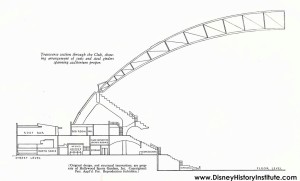 |
|
| Side View – Hollywood Sports Garden With Elevated Arena Dome |
Walt’s First Park
Part 4 – Objections and Complications
by Todd James Pierce & Paul F. Anderson
On Wednesday, March 29, Walt Disney and the Sports Garden team finalized plans for a large sales dinner to be held at the Ambassador Hotel. The room would be filled with Hollywood celebrities and a few other wealthy men—primarily men who’d made their money with oil and land. The presentation would consist of two important speakers: Zack Farmer, who was an expert on sports developments in Southern California, and Walt Disney, who was friendly with most of the people in the room. Walt, likely, spent part of his day reviewing—or even rehearsing—his speech which was prepared and typed. As with most presentations, Walt would be warm and expansive, often peppering his language with laughter, which was one reason people were drawn to him:
“I have lived [in Los Angeles] since 1923,” his speech began. “I have seen the town grow into a city. I have seen theatrical enterprises nose-dive, while sporting ventures have grown by leaps and bounds.” From here, he would offer a short history of sports in Los Angeles, including information on the 1932 Olympics, then he would gesture toward Zack Farmer, perhaps with a nod or the elevation of his hand. Zack Farmer was, after all, the evening’s featured speaker. When he had the full attention of the crowd, Walt would drop, congenially, into his final sentence: “I am now going to ask Zack to explain this project to you in a sort of brief general way, and then afterward, I would like you to ply him with questions.”
The evening would, ideally, produce tens of thousands of dollars of new support for the Garden, both in the form of club memberships and purchased stock, but even before the first guest arrived at the Ambassador Hotel, across town, the first blow would be laid to the massive sports-entertainment center planned for Hancock Park. The team, led by Disney, appears dismissive of this development, as though they believed a well-financed celebrity project, wreathed with Hollywood stars, would be welcomed with open arms in any neighborhood—let alone one so close to the studios.
The Regional Planning Commission’s hearing about the sports-entertainment development was held in the County Hall of Records at 2pm. In attendance were 300 local residents who didn’t see the sports center as an athletic venue so much as “the new amusement” arena. One business owner, R.P. McReynolds, drafted a letter urging the Commission to recommend that the empty land be zoned primarily for high-density luxury residences—thereby excluding new amusement monstrosities. “We were under the impression when we came here that the so-called Hancock Park and Gilmore properties, comprising Gilmore Island, were to be improved with high-priced apartment-houses and hotels….We are opposed to the [sports center] and request every legal effort will be made to abate what we feel is a public nuisance.” The letter was supported by a petition signed by many prominent businessmen in Gilmore Island.
The issue was further complicated because Gilmore Island, though surrounded by the City of Los Angeles, wasn’t technically part of the City. It was an unincorporated “island” of county territory inside of the city. The final decision, therefore, would not be a local one. It would be made—under advisement from the regional commission—by the County Board of Supervisors. At the end of the hearing, the Planning Commission president explained that the commission would take the issue under advisement before offering a recommendation to the county supervisors. They would also confer with the City of Los Angeles as they believed the sports center would affect city business as much as it would the unincorporated land of Gilmore Island.
It appears that no one from the Sports Garden team attended the hearing, not even Richard Bailey whose job it was to oversee the lease and generally manage the business.
The dinner presentation, it appears, went well, though none of the key members committed their impressions to paper—or at least to any paper that now survives. Most importantly the event further focused Walt’s efforts to sell stock and memberships. In the two days that followed, he corresponded with many attendees—even those who were reluctant to financially support the project. To one such person—Eddie Mannix, a vice president at MGM—he wrote: “I wish you would let me come out and tell you about Hollywood Garden. Even if you are not interested in becoming a member I should like to feel I have your moral support anyway.”
This meeting, however, would need to wait at least a week. Hours after he sent the note, Walt was on a plane to New York and Philadelphia. The trip, largely, was to coordinate with Leonard Stokowski and the Philadelphia Orchestra, who would soon record the soundtrack for Fantasia. But Walt’s enthusiasm extended beyond Fantasia; he wanted to visit the Philadelphia Arena, an indoor sports center that Zack Farmer cited as an influence on his plans for the Hollywood Sports Garden. It was one of the few places in the world, Zack Farmer had pointed out, that housed indoor ski meets, complete with hills, jumps, and ramps.
Walt’s enthusiasm for the arena can be inferred from his planning notes, where the trip was followed, uncharacteristically, by two exclamation marks. Walt, it seems, was still floating on the euphoria of—what he believed—was a sure project.

Recent Comments